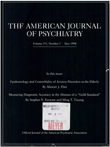Tics and Tourette's disorder: a 2- to 7-year follow-up of 54 obsessive- compulsive children
Abstract
OBJECTIVE: This study examined a hypothesized etiologic relationship between Tourette's disorder and obsessive-compulsive disorder. METHOD: Fifty-four children who had initially participated in treatment protocols for obsessive-compulsive disorder (Tourette's disorder was an exclusionary criterion) were reevaluated 2-7 years later with a neurological examination and a structured interview to establish the presence or absence of tics and Tourette's disorder. The children's first-degree relatives (N = 171) were also screened for tic disorders. RESULTS: At baseline, 57% (N = 31) of the patients had lifetime histories of tics. At follow-up, 59% (N = 32) had lifetime histories of tics; eight of these (all males) met the criteria for Tourette's disorder (six had developed the disorder, and two, it could be argued in retrospect, might have met the criteria at baseline). The patients with lifetime histories of tics had greater anxiety, a higher ratio of CSF 5-hydroxyindoleacetic acid to homovanillic acid, and a younger age at onset of obsessive-compulsive disorder than those without tics. The patients with Tourette's disorder differed from other male patients only in having an earlier age at onset of obsessive-compulsive disorder. Of the first-degree relatives, 1.8% (N = 3) had Tourette's disorder, and 14% (N = 24) had a tic disorder. CONCLUSIONS: Except for their earlier age at onset of obsessive-compulsive disorder, the patients with Tourette's disorder were indistinguishable from those without. The apparent high rate of tics and Tourette's disorder in the subjects and their relatives is consistent with the hypothesis that in some cases, obsessive-compulsive disorder and Tourette's disorder may be alternative manifestations of the same underlying illness.
Access content
To read the fulltext, please use one of the options below to sign in or purchase access.- Personal login
- Institutional Login
- Sign in via OpenAthens
- Register for access
-
Please login/register if you wish to pair your device and check access availability.
Not a subscriber?
PsychiatryOnline subscription options offer access to the DSM-5 library, books, journals, CME, and patient resources. This all-in-one virtual library provides psychiatrists and mental health professionals with key resources for diagnosis, treatment, research, and professional development.
Need more help? PsychiatryOnline Customer Service may be reached by emailing [email protected] or by calling 800-368-5777 (in the U.S.) or 703-907-7322 (outside the U.S.).



